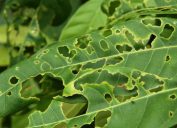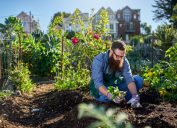If You See This Plant in Your Yard, Pull It Out Now, Experts Warn
This species can pose dangers to your other plants—and to your health.
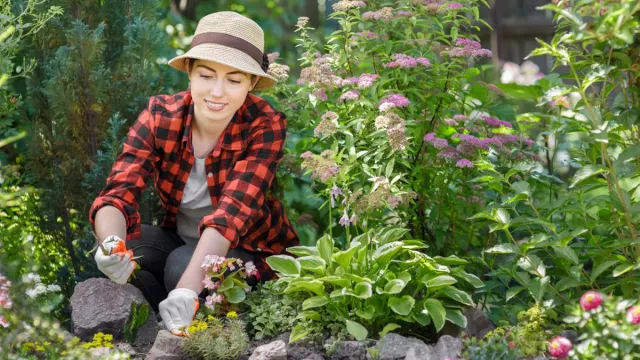
April showers have finally brought May flowers, and it seems like springtime blooms are popping up everywhere you turn. Whether you favor tulips or peonies, there's an undeniable thrill to seeing color return to the world after a long winter. But while some plants look beautiful, they can actually pose a threat to your yard—and even to your health. Read on to find out which invasive plant experts warn you should pull out immediately.
READ THIS NEXT: This Is the One Weed You Should Never Pull, Experts Say.
Invasive trees and harmful plants have already been topics of discussion this year.

In April, plant experts released a warning to anyone with a Bradford pear tree in their yard—calling for homeowners to cut them down. This species is dangerous to surrounding wildlife, as it can "choke out other plants" and produce offspring with thorns and thickets sharp enough to puncture the tires of your car, USA Today reported.
In addition, your flower beds may also have hidden dangers, as a study published on April 25 in Nature Microbiology found that they may be breeding grounds for drug-resistant mold.
Now, experts have warned that one specific plant variety could overtake your landscape or even patches of existing ground cover. And while this plant is considered edible, you'll need to proceed with caution.
READ THIS NEXT: If You Have This Tree in Your Yard, Cut It Down Now, Officials Warn.
You'll want to pull this invasive plant if you see it.
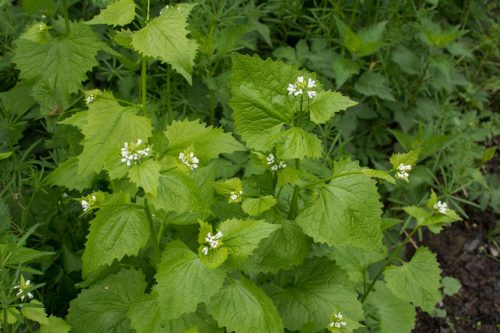
To keep your garden lush and thriving, be sure you don't have any garlic mustard lingering in your flower beds or among your bushes. The plant is classified as "terrestrial invasive" by the U.S. Department of Agriculture (USDA), as it threatens surrounding wildlife by crowding out native species.
Garlic mustard, which gets its name due to the garlicky smell of its leaves when they are crushed, was originally grown in Europe and Asia. It was introduced to North America in the nineteenth century, as it was thought to have medicinal qualities beneficial for cooking. The plant was also thought to help control soil erosion, the Nature Conservancy points out, and has been nicknamed Poor Man's Mustard, hedge garlic, mustard root, and Jack-by-the-Hedge.
Despite any positive attributes it may have, garlic mustard is harmful to the biodiversity of native ecosystems in the U.S., as it sprouts earlier than those around it, according to the Nature Conservancy. Its seeds are spread by the wind, and by setting up shop sooner in fields and forests, garlic mustard is able to block sunlight from other plants and control water and nutrient resources. To complicate things further, garlic mustard also releases chemicals through its roots that kill underground fungi—a crucial component for tree growth.
Pull-a-thons for the plant are held in different regions of the U.S.
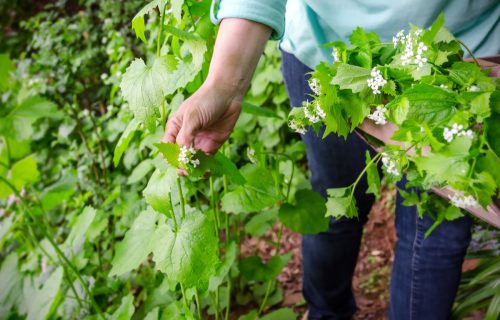
As most animals don't eat garlic mustard, it is able to spread without restraint, National Geographic points out. The plant has a two-year life cycle, and during its first year, garlic mustard germinates between February and early March, "growing into a short rosette" by mid-summer. In the second year, flowers emerge in early April, dying by June, according to New York Invasive Species Information.
The issue has become widespread, with several environmental groups organizing pull-a-thons to remove these troublesome plants. On April 4, 2022, Allegheny National Forest employees and retirees pulled garlic mustard at Backaloons Recreation Area in Pennsylvania, the Times Observer reported. In the Northeast, Midwest, and Northwest regions of the U.S.—where garlic mustard is most prevalent—other pull events have been held throughout the latter half of April, with more on the docket through mid-May.
RELATED: For more up-to-date information, sign up for our daily newsletter.
Here's how to recognize garlic mustard in your yard—and how to kill it.
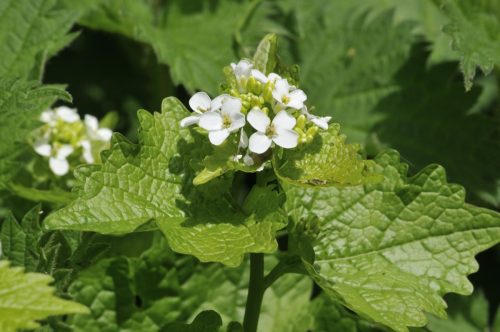
Garlic mustard leaves are rounder in their first year, and in year two, leaves become more triangular. You can recognize this plant (and know that it's two years old) thanks to its small white flowers with four petals, as well as its height, which can reach over three feet.
Garlic mustard "requires patience and persistence to get rid of," the Nature Conservancy says, and the process can take anywhere from two to five years for a specific area. The organization recommends pulling up plants before setting seed, but if you have to pull after the fact, doing so after rain (when soil is moist) is your best bet. When the ground is wet, you have a better chance of pulling out the long taproot. Do not compost disposed plants, just bag them and put them in the garbage.
According to National Geographic, plant experts disagree on how effective the process of pulling garlic mustard is, with some arguing it could be better to just leave it alone. But what researchers do agree on is the need to prevent the establishment of garlic mustard in general or catch invasions early.
If you want to try cooking with garlic mustard, do so with caution.

While many plant experts concede that garlic mustard is both tasty and high in vitamin C, zinc, and vitamin E—if you do decide to try and cook with this plant, there are certain precautions to take. More mature garlic mustard actually contains toxic hydrogen cyanide, per National Geographic, which can be avoided by chopping up the plant to release this gas. You'll also want to soak and cook garlic mustard thoroughly to reduce cyanide levels and bitterness, if you plan to capitalize on its garlicky flavor for sauces, soups, or stir fries.
READ THIS NEXT: If You See a Tree That Looks Like This, Call Officials Immediately.
